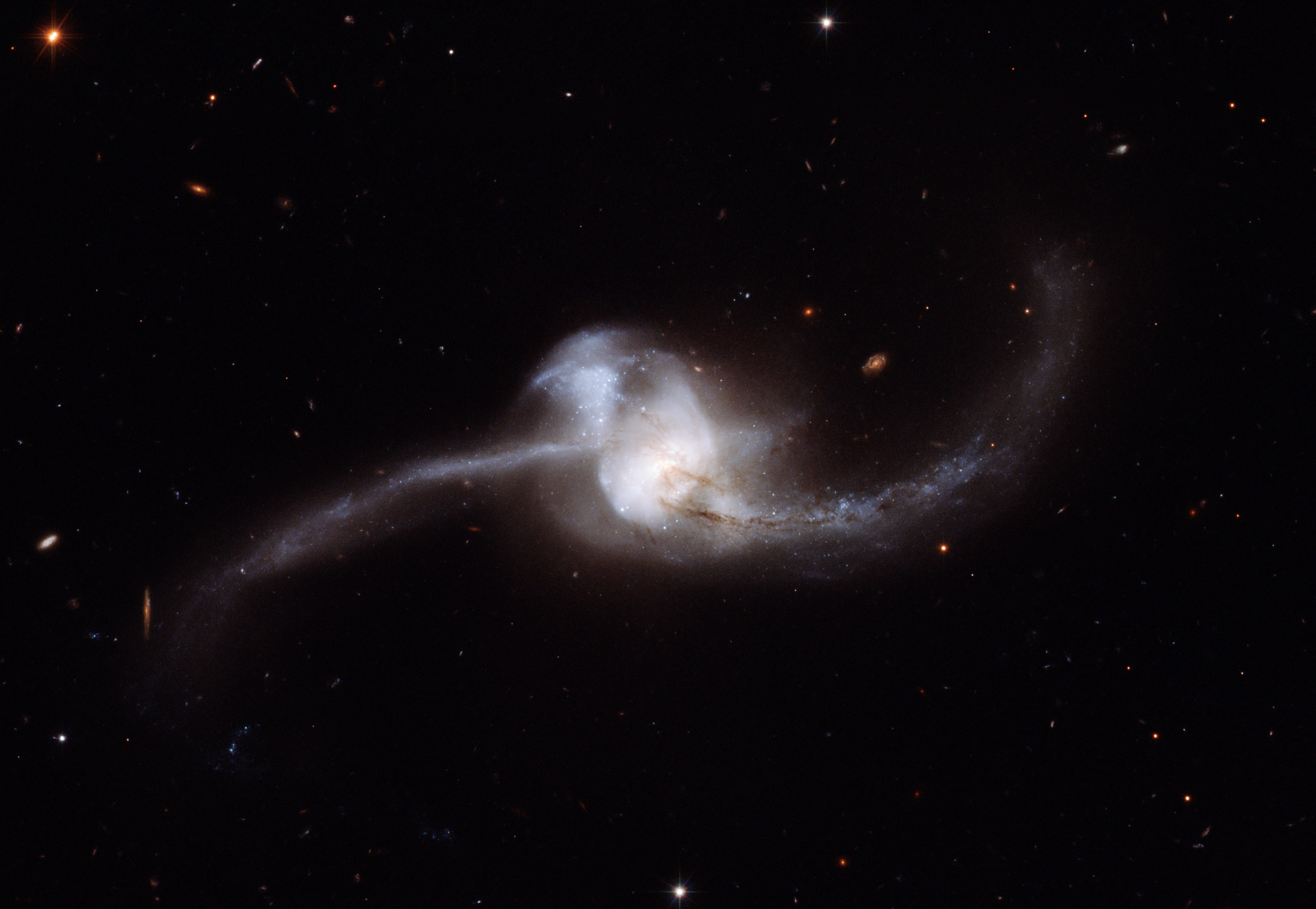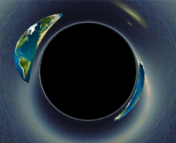Title: Close encounters of the primordial kind: a new observable for primordial black holes as dark matter
Authors: Tung X. Tran, Sarah R. Geller, Benjamin V. Lehmann, David I. Kaiser
First Author’s Institution: Center for Theoretical Physics, Massachusetts Institute of Technology, Cambridge, MA
Status: Submitted to Arxiv [Open Access]
While astrophysicists are quite confident that dark matter exists, we are much less confident about what exactly it is. And by less confident I mean we are almost completely clueless. There are two main schools of thought, dark matter is either some new particle (a weakly interacting massive particle or WIMP) or some large object that is just difficult to spot (a massive compact halo object, or MACHO). One particularly interesting possibility for a MACHO is the primordial black hole, or PBH. PBHs are theoretical black holes that would have formed in the early universe, when matter was so clumped together that a supernova was not necessary to cause the collapse into a black hole. Because of this, PBHs could have a much wider range of sizes than black holes formed later in the universe. PBHs could be a plausible candidate for the nature of dark matter as they satisfy many of the properties we observe in dark matter: being dark (duh), collisionless, slow, and forming early in the universe, see Figure 1. In order to determine if PBHs really are (or are a component of) dark matter, astrophysicists have used a variety of methods to search for them across a wide range of possible masses. As it stands, the existence of PBHs has been largely ruled out except for a small pocket of possible masses: PBHs between 1017 and 1023 grams (about the mass of an asteroid) are still fair game. Any larger, and we would have seen their gravitational lensing effects by now; any smaller, and their Hawking radiation should be observable, which we haven’t detected. However, PBHs in this small mass range could still exist and explain the existence of dark matter. The authors of today’s paper propose a new method of detecting these middling black holes in our backyard: the local solar system!
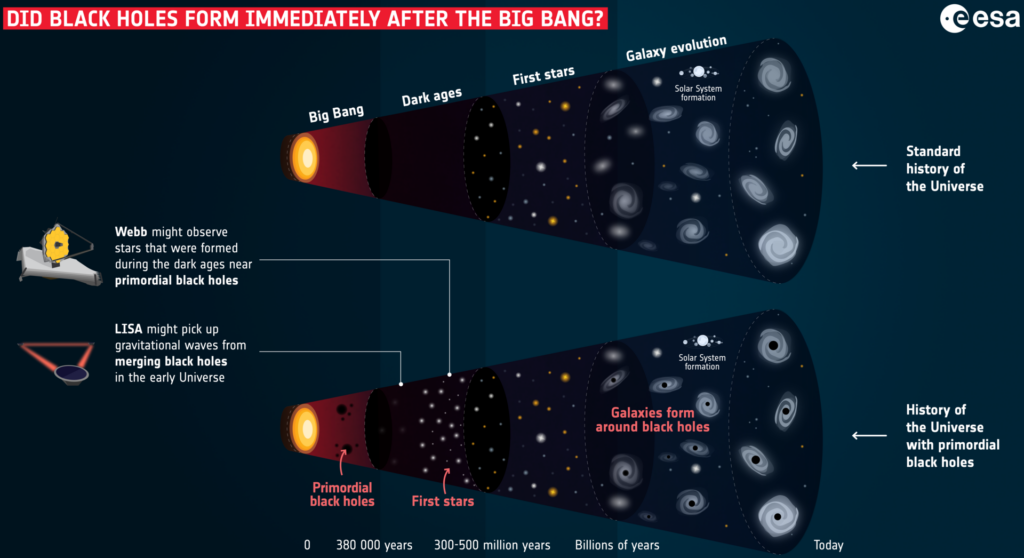
Gravity Yeeteth…
The advantage of looking for PBHs is that they should have a gravitational effect on the surrounding universe, pulling on other astronomical objects as they sail through the cosmos. If we could see other celestial bodies being jerked by some invisible object, we might be able to find a PBH. But how will we tell if an object has been yanked on by a PBH? That’s where our solar system comes in. We already have excellent maps of the solar system that keep track of planets and asteroids and their orbits, and we have gotten extremely good at measuring how far away certain objects are from earth. For instance, we are able to measure the distance from Earth to the moon to 1 millimeter precision – that’s the size of the smallest tick on a typical ruler!

The authors set out to see if it’s possible that a PBH flying past our solar system could create a noticeable change in the position of a solar system object (such a a planet) from its typical orbit. The authors start with a simple model: an analytical calculation considering only the PBH and the solar system body, similar to the set up shown in Figure 2. They find that the amount the solar system object will be moved is proportional to the mass of the PBH, and inversely proportional to how far away the PBH is and how fast it is going. Combining this information with the accuracy of the detector for the Earth-Moon distance and the estimated density of dark matter in the universe, the authors estimate that one could detect the smallest PBHs in the viable mass range (~1017 g) once per decade; we already have 3 decades of Earth-Moon distance data, so this is good news.
…and Gravity yoinketh away
Ok, so PBHs may give a noticeable jerk to objects in our solar system, so what’s to stop us from unleashing our grad students to comb through thirty years of data? Well, that calculation ignored a lot of complicated additional factors. Gravity is what caused the change in position, but it can also obscure the effect. For instance, what if PBHs are small but very numerous? Then the object we are measuring may be getting jerked this way and that all the time, not creating a single noticeable jump that we can measure. Or, what if PBHs are so massive that they pull on the Earth as well as the object we are measuring, messing with our distance measurement? The authors argue that these effects would take place, but they would start to occur below 1017 grams and above 1023 grams respectively, which was already the edge of the mass range we are curious about, so we are fine on that front. However, the authors also mention a few additional effects that could pose a problem. First, these solar system objects can change shape due to tidal forces – this squishing and squeezing allows energy to be dissipated and could weaken the effect of a PBH flyby. If you’ve ever built a sand castle at low tide, only to find a scale model of Atlantis at high tide, you know that the effects of tidal forces from the moon are not negligible here on Earth. However, the tidal forces due to Mars are a thousand times weaker. Therefore, the authors choose to use quantities like the Earth-Mars distance rather than the Earth-Moon distance to avoid this effect, even though our measurement of the Earth-Mars distance is a bit more uncertain, “only” accurate to the nearest 10 cm. The one issue that cannot be ignored is right there in the name: we live in a solar system, composed of eight planets (R.I.P. Pluto, 4.5 Billion BCE – 2006 CE), a star, hundreds of comets and millions of asteroids. How can we be certain that the effect of a PBH flyby won’t be a drop in the bucket compared to all of these competing effects?
Why speculate, when you can simulate?
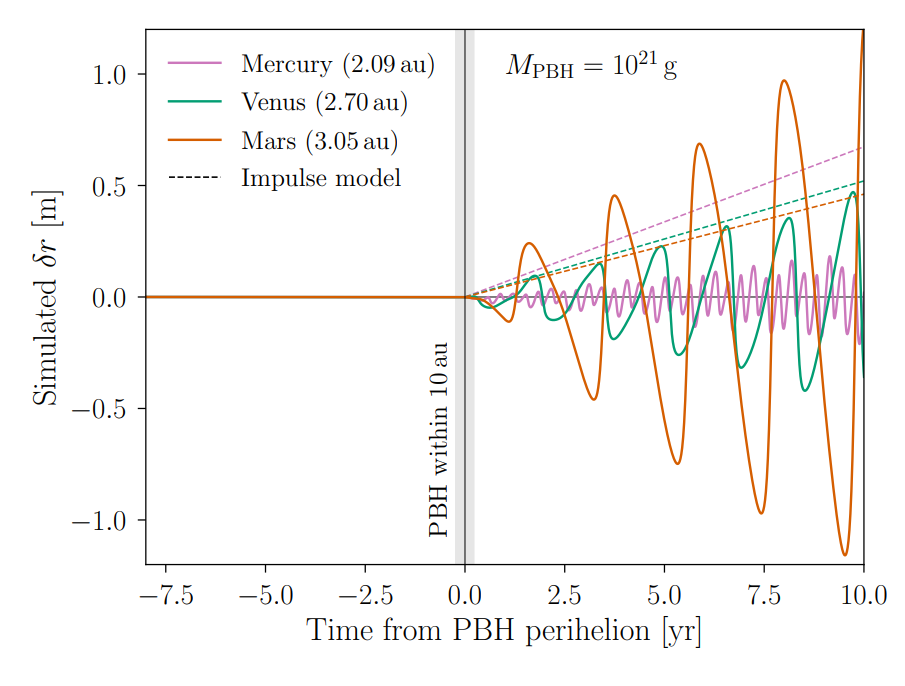
Rather than trying to do a Newtonian gravity calculation for a million objects by hand, (since this is mathematically impossible to do by hand for three objects, I imagine a million might be a tad difficult) the authors turn to simulations. To determine the effect a PBH could have on the distances between Earth and various solar system objects, they set up a simulation of 20 solar system objects with orbits that match their real life counterparts. They then perform an assortment of simulations of PBH flybys, varying the mass, initial position, and velocity of the PBH. The simulation then tracks the change in position from the unaffected solar system orbits for 20 in-simulation years to see what we would observe during this event. An example of a result from one of these simulations is shown in Figure 3.
The simulations show a surprising and promising result: the size of the displacement is larger than predicted by the simple calculation! A second promising fact is that the shape of the disturbance is periodic, i.e. it oscillates back and forth with a specific frequency. Physicists love oscillating signals as you can use some fancy mathematical tricks (thanks Fourier!) to extract even tiny oscillating signals from noisy data. For example, this is how the scientists at LIGO are able to pick up the incredibly minute wiggle of gravitational waves. But are these signals detectable? Using the information about the sensitivity of the instrument and averaging over parameters like the flyby angle, the authors produce Figure 4.
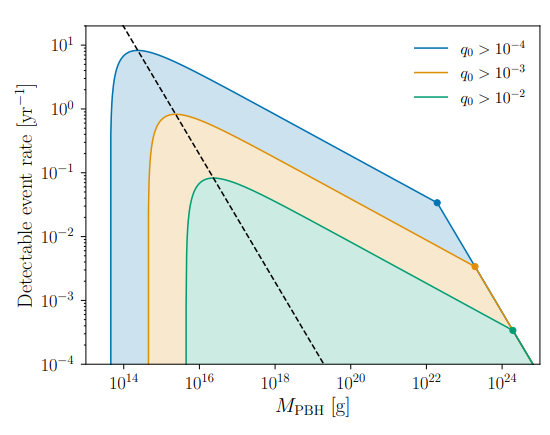
In the figure, q0 is a parameter that describes our ability to extract the effect of the PBH from noise. The blue curve represents the best case scenario, where we could extract a signal ten thousand times weaker than the noise, the sensitivity LIGO is able to achieve. To understand why sensitivity goes down at each edge of the graph, recall that we already have an estimate for the total mass of dark matter from cosmology. Therefore, if PBHs are lighter there must be more of them, resulting in many competing gravitational pulls that would be hard to measure, explaining the sharp drop off at low masses. If PBHs are larger, there must be less of them, so even if they pull harder than smaller PBHs we’d see their gravitational effect less frequently.
It seems that detection via this method may be possible, but it will depend heavily on the quality of our data and our statistical techniques. With better data and methods always under development, the authors argue this is a feasible method for searching for these primordial black holes. With this new technique under our belt, will we rule out PBHs as dark matter once and for all, or will we find that dark matter was right in our backyard the whole time?
Astrobite edited by Aldo Panfichi
Featured image credit: Wikimedia Commons

